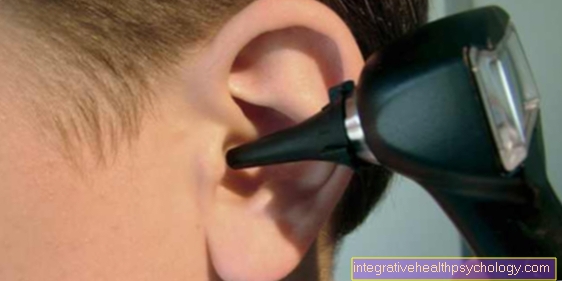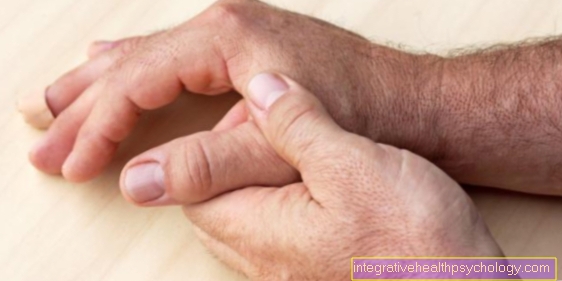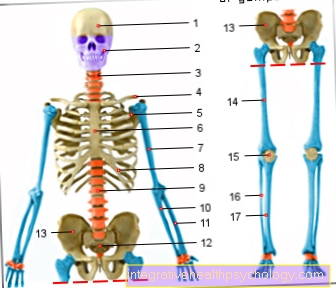Recognizing hearing impairment in children - does my child hear correctly?
definition
In order for a child to develop in accordance with their age and learn to speak correctly, intact hearing is extremely important. Temporary hearing loss, for example due to infections, is very common. However, 2-3 out of 1000 children are born with a hearing impairment that requires treatment. Since untreated hearing disorders have serious effects on the development and later life of the child, they should be diagnosed and treated as early as possible.

causes
The most common causes of hearing loss in children are colds, acute otitis media and an enlarged pharynx. The middle ear cannot be properly ventilated here because the auditory tuba, a tube that connects the middle ear with the pharynx, is closed. Accumulated liquid cannot drain and the sound is not transmitted properly.
Other causes can be congenital, acquired during or after birth. These lead to permanent hearing loss or even deafness. Congenital causes include genetic defects, gene mutations, and defective mitochondria. Hearing disorders can also occur in combination with other diseased organs. This is called syndromic hearing loss.
During pregnancy, infections, metabolic diseases, and alcohol or drug abuse can damage the child's ears. During childbirth, premature births, cerebral haemorrhages, jaundice due to blood group incompatibility, injuries caused by childbirth and lack of oxygen can all lead to hearing damage.
Other causes that can occur in childhood are meningitis, infectious diseases such as mumps, measles, rubella or an inner ear infection.
Read more about this under
- Otitis media in the baby
- Otitis media in toddlers
How do I know if my child can hear correctly?
It is often difficult to tell whether the child is hearing correctly, especially with small children. An objective test is newborn screening, which as many children as possible should participate within the first 2 to 4 days of life. Screening includes testing for the most common congenital hearing disorders. The examination takes a few minutes and is completely painless. In the best case scenario, tones are played in the ear of the sleeping child and the reaction of the ear or brain is measured. If the first test is abnormal, further tests will be carried out. Nevertheless, less frequent or later occurring hearing damage may not be recorded. In order to recognize this, it is important to watch the child closely. It is important to observe whether the child is often sick, how it reacts to loud noises and speech and how language development is, for example, in comparison with other children of the same age. Later, it is important to pay attention to school performance and the ability to socialize.
Read more about this under Preventive examination of the newborn
Signs of hearing loss in the child
It is noticeable if the child constantly has infections in the ear, nose and throat area and is prone to otitis media. Another sign is when the child reacts weakly or not at all to acoustic stimuli, for example does not startle at a loud noise or does not turn their head in the direction from which the noise is coming. Delayed, defective or non-existent language development also indicates hearing impairment. If the child is aggressive, has problems developing social contacts or has difficulties at school, such as reading and spelling disabilities, hearing should be tested.
Concomitant symptoms
If the hearing impairment is caused by a syndromic disease, further symptoms occur in other organs. Eye symptoms, pigment disorders and malformations of the face (Waardenburg-Klein syndrome), Kidney disease (Alport syndrome), Thyroid disease (Pendred syndrome) or heart defects (Jervell-Lange-Nielsen Syndrome) occur together with the hearing problems.In addition to hearing loss or deafness, speech development is usually delayed or even absent. Difficulties in the formation of sounds up to complete silence can arise. Reading and spelling difficulties can also exist due to a poor understanding of language and grammar.
Treatment / therapy
Early treatment of hearing impairments is important in order to prevent possible developmental disorders. Treatment depends on the type of disease. If the tuba auditiva is closed, an attempt must be made to open it. Enlarged tonsils are removed and a cold or otitis media treated. If these measures are not sufficient, a so-called ventilation tube can be inserted into the eardrum through which the middle ear is ventilated. The tube will usually shed on its own after a few months and the eardrum will grow closed.
If the cause of the hearing impairment is different, hearing aids are often used to amplify the sound. Cochlear implants, on the other hand, process the sound waves further and are used surgically.
In addition to these treatments, other measures are also important. Speech therapy, hearing training, learning lip reading and sign language can make everyday life much easier for children and parents.
forecast
It is difficult to make a prognosis for hearing impairments. This clinical picture is based on many different causes, which have very different courses. However, the earlier the diagnosis is made and treatment is carried out, the higher the likelihood that the child will go through normal development, especially in the linguistic and social fields. Recognizing the problem in the immediate environment can also help the child significantly in many cases. Whether or not it is expected to worsen over time depends on the underlying condition.
What can the consequences be?
The consequences of hearing impairment in the development of the child can be serious. The earlier the hearing loss occurs and the longer it lasts, the more fatal the consequences. Untreated and congenital deafness can lead to dumbness. Since the hearing pathway begins to mature before birth, the nerve cells perish if there is no stimulation. Existing problems of hearing and language can make social, emotional and intellectual development more difficult. Early diagnosis and therapy are therefore very important.





























